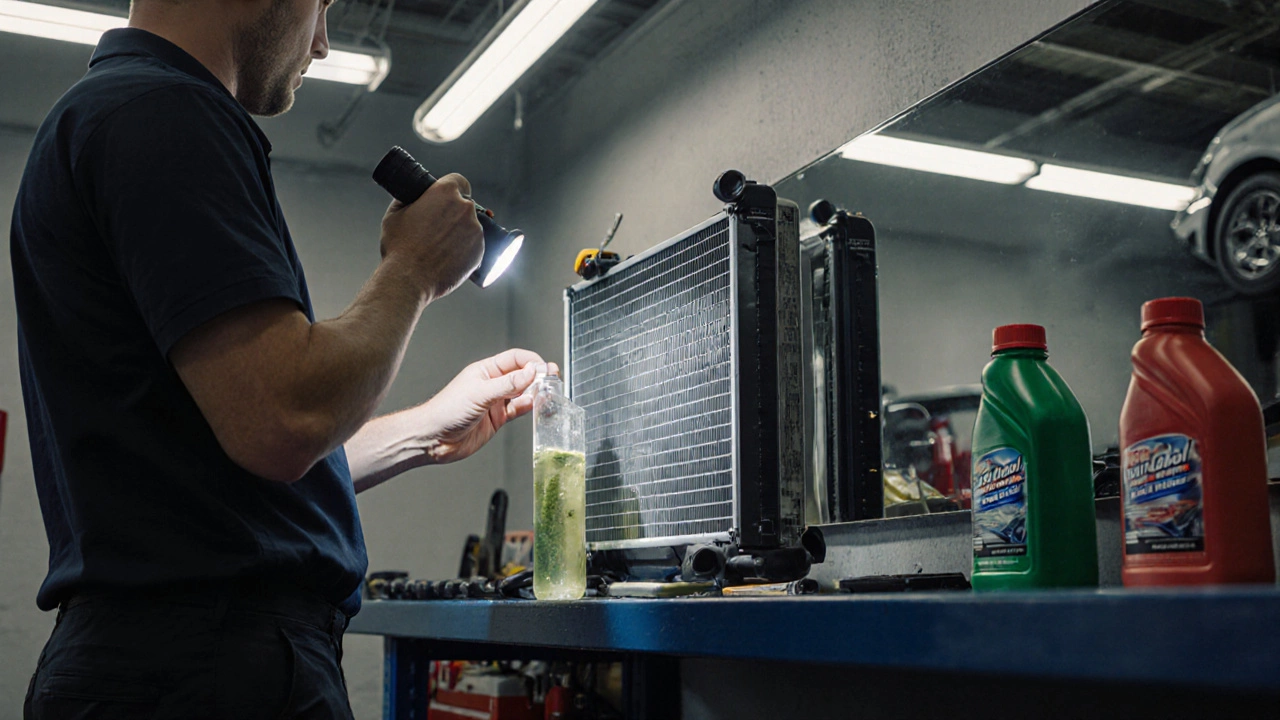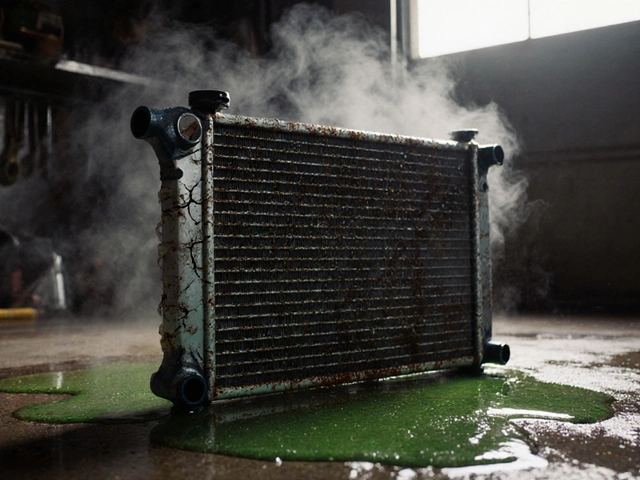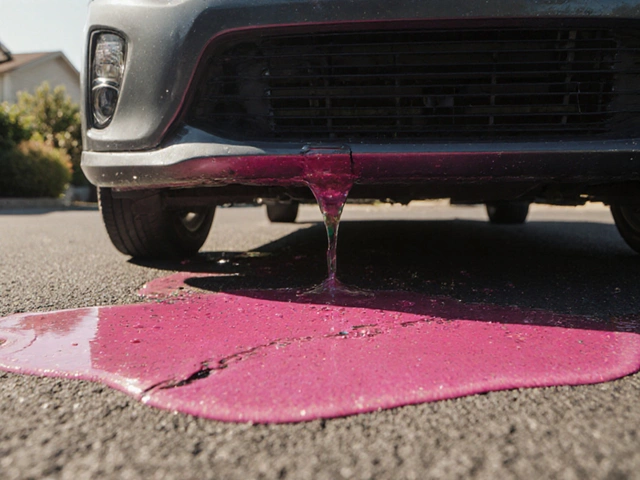Most car owners don’t think about their radiator until it fails. Then suddenly, steam is billowing from under the hood, the temperature gauge is in the red, and you’re stranded on the side of the road. The question isn’t just how many years do radiators last-it’s how do you know when yours is about to give out? The answer isn’t as simple as a number on a calendar. It depends on what kind of driving you do, what coolant you use, and whether you’ve been ignoring warning signs for years.
Typical Lifespan of a Car Radiator
A well-maintained radiator can last 8 to 12 years. That’s roughly the average life of a car in the UK. But that’s not a guarantee. Some radiators fail after 5 years. Others last 15 or more. The difference comes down to maintenance, not luck.
Modern radiators are mostly made of aluminum with plastic end tanks. Aluminum is lightweight and efficient at transferring heat, but it’s also more vulnerable to corrosion than the old brass-and-copper radiators. Plastic end tanks can become brittle over time, especially when exposed to extreme heat and cold cycles. That’s why a 10-year-old radiator in Manchester, with its damp winters and frequent short trips, might be in worse shape than one in a dry, warm climate.
Here’s what actually affects radiator life:
- Coolant condition - Old or dirty coolant turns acidic and eats away at metal parts.
- Driving habits - Constant stop-and-go traffic, towing, or aggressive driving heats up the engine faster and puts more stress on the cooling system.
- Environmental factors - Road salt in winter, dust, and debris clog radiator fins and reduce airflow.
- Maintenance neglect - Skipping coolant flushes is the #1 reason radiators fail early.
Signs Your Radiator Is Failing
You don’t have to wait for the engine to overheat to know something’s wrong. These signs show up long before total failure:
- Constant low coolant levels - If you’re topping up coolant every few weeks, there’s a leak. It could be a cracked hose, a bad cap, or a leaking radiator.
- Visible coolant leaks under the car - Green, orange, or pink fluid pooling near the front of the engine bay? That’s not normal. Radiator leaks often show up near the bottom corners where the plastic meets the metal.
- Rusty or sludgy coolant - When you check the coolant reservoir, if it looks like muddy tea instead of bright fluid, the system is corroding from the inside. That sludge clogs the radiator tubes and stops heat from escaping.
- Overheating at low speeds - If your car runs fine on the motorway but overheats in traffic, the radiator isn’t moving enough air. Fins could be clogged, or the electric fan isn’t working.
- Discolored or oily coolant - If your coolant has a milky, creamy look, that’s engine oil mixing with coolant. That means a blown head gasket, which can destroy the radiator quickly if ignored.
One real-world example: A 2015 Ford Focus in Manchester had coolant leaks every winter. The owner kept topping it up and ignored the warning light. After three years, the radiator cracked completely. The repair cost £650. Had they flushed the coolant every two years, it would’ve cost £80 and lasted another 5 years.
How Often Should You Flush the Coolant?
Most manufacturers say to flush the coolant every 30,000 to 50,000 miles-or every 2 to 5 years. But that’s a minimum. In the UK, where winters are harsh and many drivers take short trips (which don’t let the engine reach full operating temperature), you should flush it every 2 years.
Why? Short trips mean condensation builds up in the cooling system. That water mixes with old coolant and creates acid. Acid eats aluminum. It also corrodes the water pump, thermostat, and heater core. Flushing removes that acid and replaces it with fresh inhibitor chemicals that protect the system.
Use the coolant type your car manual recommends. Don’t mix types. Orange Dex-Cool, green traditional, or blue long-life-each has different chemical formulas. Mixing them can cause gels or sludge that clog the radiator.

What Happens When a Radiator Fails?
A failed radiator doesn’t just mean overheating. It can destroy your engine. Here’s the chain reaction:
- Radiator leaks or clogs → engine overheats
- Overheating causes head gasket to blow
- Blown head gasket lets coolant into cylinders → engine misfires
- Continued overheating warps the cylinder head
- Repair now costs £2,000+ instead of £400 for a radiator
That’s why a £300 radiator replacement is a bargain compared to a £1,800 engine rebuild. Many mechanics in Manchester say they see 3-4 engine failures a month from neglected cooling systems. That’s preventable.
Can You Extend Your Radiator’s Life?
Yes. Here’s how:
- Flush coolant every 2 years - Even if your manual says 5. It’s cheap insurance.
- Check coolant level monthly - Do it when the engine is cold. Top up only with the correct coolant mix.
- Inspect radiator fins - Look for bent or clogged fins. Use a soft brush or compressed air to clean them. Don’t use a pressure washer-it can damage the core.
- Replace the radiator cap - It’s a simple part, but it maintains pressure in the system. A weak cap can cause boiling and leaks. Replace it every 5 years or when you flush the coolant.
- Avoid running the engine low on coolant - Even a half-quart low can cause hot spots in the engine that crack the radiator.

When to Replace Your Radiator
You don’t need to replace a radiator just because it’s 8 years old. But you should replace it if:
- There’s a visible leak you can’t fix with a sealant
- Corrosion is eating through the metal or plastic
- It’s clogged and flushing didn’t help
- You’ve had repeated overheating issues
- The repair cost is more than 60% of a new radiator’s price
After-market radiators are reliable and cheaper than OEM. Brands like Behr, Valeo, and Denso make units that match or beat factory specs. Avoid the cheapest no-name brands-they often have thinner tubes that fail faster.
If you’re replacing the radiator, replace the thermostat and hoses at the same time. They’re all connected. If one’s old, the others are too.
What About Electric Radiators in EVs?
Electric vehicles don’t have traditional radiators. They use liquid-cooled battery packs and power electronics, which function similarly. These systems are sealed and require no maintenance. But if you own a hybrid or plug-in hybrid, it still has a traditional radiator for the internal combustion engine. Those still need the same care.
So if you’re driving a Toyota Prius or a Ford Kuga Hybrid, your radiator still needs coolant flushes. Don’t assume “electric” means “maintenance-free.”
Final Takeaway
There’s no magic number for how long a radiator lasts. But you control most of the variables. Flush the coolant every two years. Watch for leaks. Don’t ignore warning lights. Check the fluid. Clean the fins. These small steps add up.
A radiator that lasts 12 years isn’t lucky. It’s maintained. And if yours is approaching 8 years, don’t wait for steam to come out of the hood. Get it checked. It could save you thousands-and a very long tow truck wait on a cold Manchester morning.
How long should a car radiator last on average?
On average, a well-maintained car radiator lasts 8 to 12 years. But this depends heavily on coolant maintenance, driving conditions, and whether leaks or corrosion are ignored. In the UK, with short trips and wet winters, many radiators fail before 8 years if coolant isn’t flushed regularly.
Can a radiator last 15 years?
Yes, but only if it’s been properly maintained. Radiators in vehicles with regular coolant flushes, clean air flow, and no overheating incidents can last 15 years or more. This is common in cars driven long distances on highways with consistent maintenance schedules. However, it’s rare in city cars or vehicles with neglected cooling systems.
What causes radiators to fail early?
The top causes are old or contaminated coolant, frequent short trips that don’t let the engine warm up fully, and neglecting coolant flushes. Corrosion from acidic coolant eats aluminum and plastic parts. Road salt, debris blocking radiator fins, and a faulty radiator cap also speed up failure.
How often should I flush my radiator coolant?
Flush your coolant every 2 years or 30,000 miles, whichever comes first-especially in the UK. Even if your manual says 5 years, short trips and damp weather create moisture and acid in the system. Flushing removes that buildup and prevents corrosion that leads to leaks and blockages.
Is it worth repairing a leaking radiator or should I replace it?
Most radiator leaks can’t be reliably repaired. Sealants are temporary fixes at best and often clog the cooling system. If the leak is from a crack in the core or a failed plastic end tank, replacement is the only lasting solution. Repairing a radiator usually costs nearly as much as replacing it-and doesn’t guarantee it won’t leak again.
Can a bad radiator damage my engine?
Absolutely. A failing radiator causes overheating, which can warp the cylinder head, blow the head gasket, or even crack the engine block. These repairs cost 5 to 10 times more than replacing a radiator. Ignoring a leaking or overheating radiator is one of the most expensive mistakes a car owner can make.


